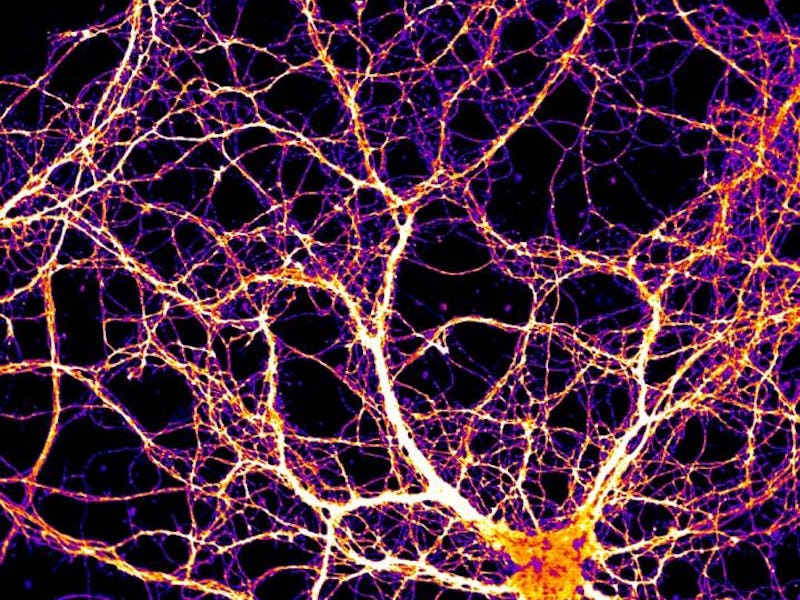All Your Memories Are Stored by One Weird, Ancient Molecule
We actually borrowed our ability to form memories from viruses.

How does memory work? The further we seem to dive in, the more questions we stumble upon about how the function of memory first evolved. Scientists made a key breakthrough with the identification of the Arc protein in 1995, observing how its role in the plastic changes in neurons was critical to memory consolidation.
This protein is already a big deal, but the Arc picture just got a lot more interesting. In a study published Thursday in the journal Cell, a team of researchers at the University of Utah, the University of Copenhagen in Denmark, and MRC Laboratory of Molecular Biology in Cambridge, UK, argue that Arc took its place in the brain as a result of a random chance encounter millions of years ago. Similar to how scientists say the mitochondria in our cells originated as bacteria that our ancient ancestors’ cells absorbed, the Arc protein seems to have started as a virus.
Much as a virus infects host cells, Arc can deliver genetic material to brain cells.
The researchers knew they were onto something when they captured an image of Arc that looked an awful lot like a viral capsid, the isohedral protein coat that encapsulates a virus’s genetic material for delivery to host cells during infection.
“At the time, we didn’t know much about the molecular function or evolutionary history of Arc,” says study coauthor Jason Shepherd, an assistant professor of neurobiology, anatomy, biochemistry, and ophthalmology at the University of Utah, in a statement. Shepherd has studied Arc for 15 years. “I had almost lost interest in the protein, to be honest. After seeing the capsids, we knew we were onto something interesting.”
The main issue that challenges neuroscientists’ understanding of memory is that proteins don’t last very long in the brain, even though memories last nearly a lifetime. So for memories to remain, there must be plastic changes, meaning that neuron structures actually have to change as a result of memory consolidation.
This is where Arc comes into play. Previous research on rats illustrated how Arc disrupts memory consolidation, suggesting that Arc is vital in neuronal plasticity.
But scientists never thought they would stumble on evidence that pointed to a viral origin for Arc, as these new findings suggest.
The research team needed to verify this theory, so they tested whether Arc actually acts like a virus. It turns out the Arc capsid encapsulated its own RNA. When they put the Arc capsids into a mouse brain cell culture, the capsids transferred their RNA to the mouse brain cells — just like viral infection does.
“We went into this line of research knowing that Arc was special in many ways, but when we discovered that Arc was able to mediate cell-to-cell transport of RNA, we were floored,” says the study’s lead author, postdoctoral fellow Elissa Pastuzyn, Ph.D., in a statement. “No other non-viral protein that we know of acts in this way.”
The researchers suspect this virus-mammal collaboration happened sometime between 350 and 400 million years ago when a retrotransposon — the ancestor of modern retroviruses — got its DNA into a four-legged creature. They also suspect that this happened more than once. If they’re right, this research complicates the picture of the evolution of life as we know it. Not only did many mutations happen by random chance to make us what we are today, but we actually borrowed biology from other cells and organisms to get here. A little bit of their history lives on in us today.
Abstract: The neuronal gene Arc is essential for long-lasting information storage in mammalian brain, mediates various forms of synaptic plasticity, and has been implicated in neurodevelopmental disorders. However, little is known about Arc’s molecular function and evolutionary origins. Here, we show that Arc self-assembles into virus-like capsids that encapsulate RNA. Endogenous Arc protein is released from neurons in extracellular vesicles that mediate the transfer of Arc mRNA into new target cells, where it can undergo activity-dependent translation. Purified Arc capsids are endocytosed and are able to transfer Arc mRNA into the cytoplasm of neurons. These results show that Arc exhibits similar molecular properties of retroviral Gag proteins. Evolutionary analysis indicates that Arc is derived from a vertebrate lineage of Ty3/gypsy retrotransposons, which are also ancestors to retroviruses. These findings suggest that Gag retroelements have been repurposed during evolution to mediate intercellular communication in the nervous system.